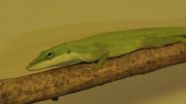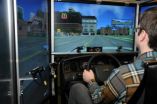(Press-News.org) Armored spiders are medium to small species that derive their name from the complex pattern of the plates covering their abdomen strongly resembling body armor. Lurking in the darkness of caves In Southeast China, scientists discover and describe five new species of these exciting group of spiders. The study was published in the open access journal ZooKeys.
The common name armored spiders is given to the engaging family Tetrablemmidae. Distinguished by their peculiar armor-like abdominal pattern, these tropical and subtropical spiders are mainly collected from litter and soil, but like the newly described species some live in caves. Some cave species, but also some soil inhabitants, show typical adaptations of cave spiders, such as loss of eyes. The genus Tetrablemma, for example, to which two of the new species belong, is distinguished by having only 4 eyes.
All these new spiders are collected from the South China Karst, a UNESCO World Heritage Site. The South China Karst spans the provinces of Guangxi, Guizhou, and Yunnan. It is noted for its karst features and landscapes as well as rich biodiversity. UNESCO describes the South China Karst as "unrivalled in terms of the diversity of its karst features and landscapes."
Colleagues from the Chinese Academy of Sciences under the leadership of Professor Shuqiang LI have investigated more than 2000 caves in the South China Karst. Several hundred new species of cave spiders are reported by Shuqiang Li and colleagues. As a result, the total known spider species of China increased from 2300 species to 4300 species in the last 10 years.
INFORMATION:
Original Source:
Lin Y, Li S (2014) New cave-dwelling armored spiders (Araneae, Tetrablemmidae) from Southwest China. ZooKeys 388: 35. doi: 10.3897/zookeys.388.5735
Lurking in the darkness of Chinese caves 5 new species of armored spiders come to light
2014-03-14
ELSE PRESS RELEASES FROM THIS DATE:
Dartmouth researchers develop new approach to chronic lymphocytic leukemia treatment
2014-03-14
March 14, 2014 Lebanon, NH - Dartmouth researchers have developed a novel and unique approach to treating Chronic Lymphocytic Leukemia (CLL), a form of blood cancer that often requires repeated chemotherapy treatments to which it grows resistant. The researchers, led by Alexey V. Danilov, MD, PhD, assistant professor at the Geisel School of Medicine at Dartmouth and Hematologist-Oncologist at the Norris Cotton Cancer Center, modeled the lymph node microenvironment where CLL cells are found in the laboratory. They were able to disrupt the activity of a pathway (NF-kappaB) ...
Bone lengthening technique proves useful in patients with cleft palate
2014-03-14
Philadelphia, Pa. (March 14, 2014) - A technique called distraction osteogenesis can create increased length of the upper jaw in patients with cleft lip and palate deformities, reports a study in the March issue of The Journal of Craniofacial Surgery, edited by Mutaz B. Habal, MD, published by Lippincott Williams & Wilkins, a part of Wolters Kluwer Health.
Distraction Technique Used to Lengthen the Palate
Dr. Emeka Nkenke of Erlangen University Hospital, Germany, and colleagues, report on the use of distraction osteogenesis to lengthen the maxilla (upper jaw) bone in ...
Big data tackles tiny molecular machines
2014-03-14
HOUSTON – (March 13, 2014) –Open, feed, cut. Such is the humdrum life of a motor molecule, the subject of new research at Rice University, that eats and excretes damaged proteins and turns them into harmless peptides for disposal.
The why is obvious: Without these trash bins, the Escherichia coli bacteria they serve would die. And thanks to Rice, the how is becoming clearer.
Biophysicists at Rice used the miniscule machine – a protease called an FtsH-AAA hexameric peptidase – as a model to test calculations that combine genetic and structural data. Their goal is to ...
Older adults: Build muscle and you'll live longer
2014-03-14
New UCLA research suggests that the more muscle mass older Americans have, the less likely they are to die prematurely. The findings add to the growing evidence that overall body composition — and not the widely used body mass index, or BMI — is a better predictor of all-cause mortality.
The study, published in the American Journal of Medicine, is the culmination of previous UCLA research led by Dr. Preethi Srikanthan, an assistant clinical professor in the endocrinology division at the David Geffen School of Medicine at UCLA, that found that building muscle mass is ...
New cell line should accelerate embryonic stem cell research
2014-03-14
Researchers at the University of Washington have successfully created a line of human embryonic stem cells that have the ability to develop into a far broader range of tissues than most existing cell lines.
"These cells will allow us to gain a much greater understanding of normal embryonic development and have the real potential for use in developing ways to grow new tissues and organs for transplantation," said Carol Ware, a professor in the UW Department of Comparative Medicine and lead author of a paper describing the new cell line appearing in the March 10 issue ...
Motion and muscles don't always work in lockstep, researchers find in surprising new study
2014-03-14
RIVERSIDE, Calif. — Animals "do the locomotion" every day, whether it's walking down the hall to get some coffee or darting up a tree to avoid a predator. And until now, scientists believed the inner workings of movement were pretty much the same — the nerves send a message to the muscles and there is motion.
But in a first-of-its-kind study on wild green anole lizards, biologists at the University of California, Riverside have discovered that the link between muscle function and movement is a lot more complicated than anyone realized.
"We were trying to understand ...
Critical role of one gene to our brain development
2014-03-14
Research from the University of Adelaide has confirmed that a gene linked to intellectual disability is critical to the earliest stages of the development of human brains.
Known as USP9X, the gene has been investigated by Adelaide researchers for more than a decade, but in recent years scientists have begun to understand its particular importance to brain development.
In a new paper published online in the American Journal of Human Genetics, an international research team led by the University of Adelaide's Robinson Research Institute explains how mutations in USP9X ...
Drivers with hemianopia fail to detect pedestrians
2014-03-14
BOSTON (March 14, 2014) — A diagnosis of hemianopia, or blindness in one half of the visual field in both eyes as the result of strokes, tumors or trauma often means the end of driving.
In about half of the states in the United States and in many other countries, driving with hemianopia is prohibited. However, in some countries including Belgium, the Netherlands, the UK, Switzerland and Canada, driving with hemianopia is permitted after passing a specialized road test. Researchers at Massachusetts Eye and Ear/Schepens Eye Research Institute set out to determine the extent ...
New findings show link between diabetes and pancreatic cancer
2014-03-14
In a new study published today in Annals of Surgical Oncology, clinicians worked with mathematicians to review data from 1973 to 2013 to conclude there was a time-dependent link between being diagnosed with diabetes and pancreatic cancer.
A review of 88 international studies to date, is the largest analysis on the topic published.
Dr Mehrdad Nikfarjam, liver, pancreas and biliary specialist from the Department of Surgery at the University of Melbourne said pancreatic cancer was often diagnosed when at an advanced, incurable stage.
"This is an important paper that ...
New stratigraphic research makes Little Foot the oldest complete Australopithecus
2014-03-14
After 13 years of meticulous excavation of the nearly complete skeleton of the Australopithecus fossil named Little Foot, South African and French scientists have now convincingly shown that it is probably around 3 million years old.
In a paper published today, Friday, 14 March 2014 at 12:00 (SATS), in the scientific journal, the Journal of Human Evolution, the latest findings by Professor Ron Clarke from the University of the Witwatersrand and his colleagues refute previous dating claims that suggested Little Foot is younger. (See the all authors' details and affiliations ...




